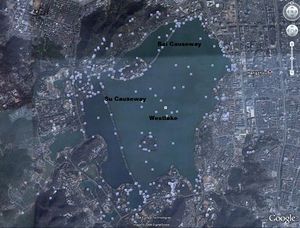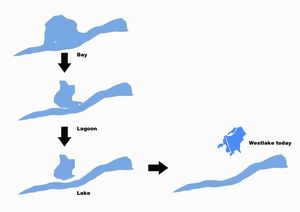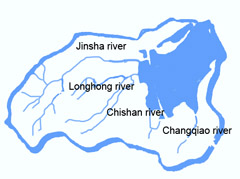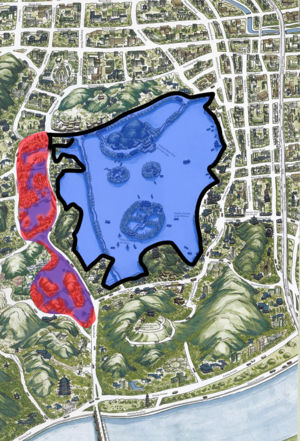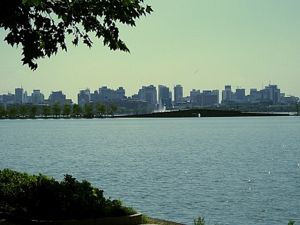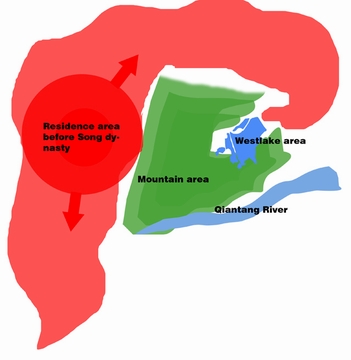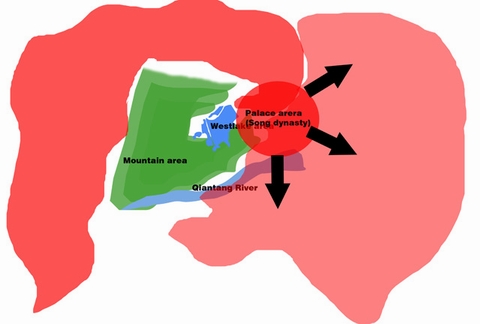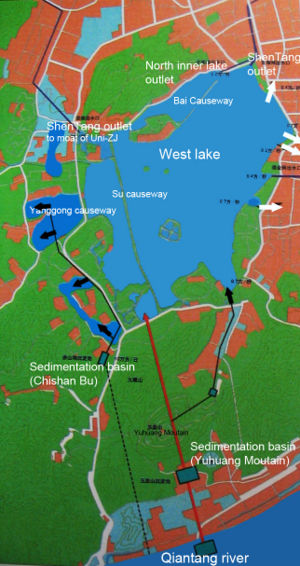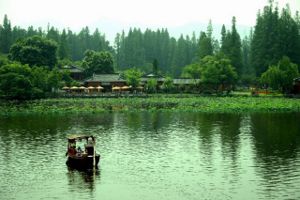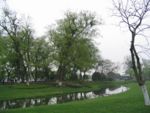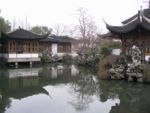Hangzhou: Difference between revisions
| Line 107: | Line 107: | ||
*How has it been shaped? Were there any critical decisions? | *How has it been shaped? Were there any critical decisions? | ||
[[Image:Map_of_West_lake1_copy.jpg|left|thumb]] | |||
The whole project is roughtly divided into two parts.The west part of lake, previously | |||
=== Core Questions Working Group Nature Conservation / Water === | === Core Questions Working Group Nature Conservation / Water === | ||
Revision as of 13:56, 5 January 2009
weave a new memory for Westlake (Hangzhou, China)
Rationale: Why is this case study interesting?
It has never been such a story and would never be such a story which could clarify the relationship between human, city, life and nature more expressively in Chinese history. The story is deposited by struggles, hardship, repetitions, as well as joy, triumph and harmony.
Westlake, located in center of the city Hangzhou, boast one of the most prominent scenic spots in China. The coexistence of the city and the lake has gone through more than thousand years. The lake is surrounded by mountains from three sides and face with the dense urban construction on eastside. In this senses, westlake and the adjacent mountain played a critical role in prevent the sprawl and actually become the last oasis without being perished.
In 2002, the third time of dredging and comprehensive protection project of Westlake. Hangzhou China, was initialized. Superficially, it was only one of thousands dredging projects in the history of Westlake. However, considering the pretermission during the last 300 years, the quality of lake existence, the symbiotic relationship between human and lake had deteriorated into a severe condition, this project carried more commissions both ecologically, culturally and pragmatically. Meanwhile, this project connected the grand cannel, Qiantang river,to the Westlake, which enable an extensive water flowing and subsequently boost the self cleaning capacity of the natural water body in this area.
Author's perspective
- What theoretical or professional perspective do you bring to the case study?
Landscape and/or urban context
- Biogeography, cultural features, overall character, history and dynamics
Illustration: Map; sketches; short descriptive analyses
Generally Introduction West lake is located in the very center of Hangzhou city,the capital city of Zhejiang province, which boasts the most prosperous region in southeast of china. North to Westlake situated Qiantang riverwhich is the origin of Westlake. Qiantang river flows into the East China Sea through Hangzhou Bay. it is also the southern terminal of the ancient Grand Canal. The whole area of Westlake covers 6.38km2, Annual run-off is around 14,000,000m3 while freuquncy of water substitution is once per year.
The geographical evolution of Westlake
Trace back to the origin and history of West lake, the whole span of the lake falls into two phases with the former one attribute to no more than a natural evolution of a lake——from a bay nearby the Yangzi delta, to a lagoon and finally enclosed by alluvial clay from Qiantang river. This is approximately the phenotype of the Westlake we are familiar with. However, if evolution was straightly going through, the lake should have been swallowed by the sands and sendiment from streams which connect Qiantang river and Westlake, then finally be converted into farm land or swamp. However, the settlement of inhabitants in this area absolutely changed the fate of Westlake, as a result unravel the second phase of Westlake——from a natural lake to an artificial lake that is protected by dam and dredged consistently. Due to the need of drinking water for the increasing population, whereas all the water from river, even from the wells deeply digged in this region are all contaminated with the salty water from east China sea, the residents had to rely on the precious eligible water from Westlake. The coexistence relationship was reinforced with the establishment of Hangzhou as a capital city of China in Song dynasty.The political decision obviously place westlake in a more significant status and therefore, the revitalisation of westlake became the rountine exploit of each dynasty and each emperor either in aesthetical way or ecological way.
status before compeletion of protection project
landscape feature
Westlake is divided by Gu Shan, Bai, Su Causeways into five areas. They are outer lake,Inner lake, north inner Lake,south lake and Yue Lake ordered by areas. Three man-made islands, "Xiao Ying Zhou", "Hu Xing Ting", "Ruan Gong Dun" lie in the center of outer west Lake, which is also accordfully follow the tradition "one lake three islands". Thus formed the famous layout of Westlake "one hill, two causeways, three islands, and five lakes". "Ten Scenes of the West Lake", the legendarly collection of ten scenic views formed during the Southern Song Dynasty and are distributed around and within the lake, They have their names inscribed in the list of most prominent scenary spots in China.
- Leifeng Pagoda in the Sunset
- Fish Viewing at the Flower Pond
- Orioles Singing in the Willows
- Three Ponds Mirroring the Moon
- Lotus Pool in Summer
- Twin peaks piercing the clouds
- Spring dawn in Su Causeway
- Late night bell at the Nanping Hill
- Autumn moon on calm lake
hydrology
Except for rain water, the compensation of Westlake was mainly generated from four natural runoffs:(from north to south) Jinshan river, Longhong river, Chishan river, and Changqiao river
The rapid industrialization and economics development since 1978 in China was in some sense obtained at the cost of the loss of ecological balance. Westlake was unexceptionally suffering from a severe pollution derived from industrial manufacture outlet, trash abandoned by tourists, along the watefron. In order to attain a relative clean waterbody, Qiantang River was connected to Westlake during the second Westlake protection project (1985 AD) by around 2800 transportation tunnel. The water sucked from Qiantang river was split into two parts, one of which injected into inner lake, while the other pour into outer river. In 1987, to match the new inflow from Qiantang river on south side, Shentang sluice was reconstructed to enhance the outlow on north side.
Ecosystem:
- Forest ecosystem
- Freshwater ecosystem
- Wetland ecosystem
Freshwater and Wetland ecosystem were severely perished because of the eutrophication, overgrow of phycophyta and sediment intrusion, which obsessively damaged the health of Westlake since the beginning of its formation.
administration The prominent "Ten scenic sopts of Westlake" attracted millions of tourists each year.The profit came from fee charged from tourists were always a significant income for government, To raise money in this sense, the whole region of Westlake (waterfront) was divided into several pieces mainly in terms of scenic spots, which was isolated from each other by fences, walls. This sort of small pieces of waterfront area were made to be like the so called "Park" (Orioles Singing in the Willows Park, Gerontic Park, Juvenile Park and Long Bridge Park for example)after all and were ruled by organizations independently.Ticket was also charged independently to everybody except for certain group of users (elders and youth).
Cultural/social/political context
Cultural Context The cultural history of Westlake has been described in detail by countless of books, both inside and outside of China. Obviously Westlake is a attractive place full of legends and stories which even appeal to people nowadays and inspire the passion of art work creating from artist, poet. A brief introduction of Westlake history can be seen in the subpage West lake in Wikipedia
However, Su causeway and Bai causeway, the masterpieces owe to the exploit from Su Shi and Bai Juyi, both of who were the top artists and officials as well at their own time, is particularly worth mentioning here to elicit their talents, this creatively merged the aesthetic feature into hydrological feature.
Political context of the comprehensive project of Westlake
In spite of the governmentally organized measures taken since 1949, which include routine dredging by employing ferry boat, channeling various water source to purify the water quality, issued regulation to impose the legal obligation on individual and firms, which attempt to avoid the pollution caused by unscrupulous dumping of trash, the quality of the water of Westlake did not improve a lot due to the loose administration, natural eutrophication process of Westlake.
In 1990s, the plan of Comprehensive protection project of Westlake was conceived mainly because Westlake, one of the famous cultural and social heritage of China, started the procedure to apply for the world natural and cultural heritage site.
History
- How did the area/project/plan at the focus of the case study evolve?
Illustration: Table or time line
Spatial analysis of area/project/plan
- What are the main structural features?
- How has it been shaped? Were there any critical decisions?
The whole project is roughtly divided into two parts.The west part of lake, previously
Core Questions Working Group Nature Conservation / Water
What is the role of user groups?
Although Hangzhou is usually seen as the “shanshui" city( the city located in the landscape with moutain and river), which indicate the resourse of nature heritage.Westlake obviously tend to be the key component due to the very location. the users actually include all kinds of people living in the city and also, people pass by to follow the trace of story accumulated in the long histroy of Westlake.
What is the role of the city?
The coexistence of city and lake is pretty striking in this case. Initially, the lake served as a functional element for the city with which development, the lake is no longer used as a source of drinking water.The lake, with the mountain beside the lake, are enclosed by the city and actually doomed to be dependend on the development of the city.
How do urban and natural structures interact?
Westlake is surrounded by mountain from three sides. To this point, only one side was left to attach the border of "urban" structure. The east border of west lake remians a tough problem for all the designers to cope with.The natural shore from the other three sides, which dotted with numerous amazing senic spot and fauna shed with beatufifully shaped peaks, dimmed the concrete forest along the east side. The skyscrapers, build up were just one lane away from east side of Westlake without any shield.This problem remains unsettled during this project,however,we anticipate in the next 10 years,municiple government of Hangzhou can take measure to prevent the city sprawling by either demolish certain existed buildings or draft relative regulation to control the building of highrises.
What is the role of water?
Compared to the city, which is the leading domain in the 'coexistence' relationship. the water is changed by the activities of human being. Nowadays, the role of the lake is purely for recreation, which boasts as the most famous scenery spot in China. It is because of the significance of the culture heritage it carries that make the existence of the lake more prominent than ecological means.
What is the evolution of the urban relation between humans and nature?
The first span of Westlake is non-artifical, which was kept until people started to settle down in the lake region, the humid place with salty land, which supposed to be unsuitable to live on. During the second span of Westlake, the "human" plays a leading role in deciding the fate of Westlake, mainly due to the need of edible water to satisfy the daily use of local inhabitants at first, and then gradually developed fish breeding to feed the exploded population, the dredging act is never ended. The aesthetic function of Westlake was firstly established in Tang dynasty, and outreached the other functions in Song dynasty, while Hangzhou (Lin An) was chosen to be the capital of Nansong. Served as a backup recreational site, The popularity of Westlake as a scenic spot had been won not only among the royal members, but also scholars, bureaucrats, poets, painters and even normal people. The artificial influence released by human being was reached its zenith and never be changed again in the next thousands of years.
The chronicle of dredging project in the chinese history
Year Dynasty Measure 766-779 Tang Six wells were digged to channel the water from westlake to the inner city in order to offer the edible water to the inhabitants in Hangzhou
around 822 Tang A dam was builded to protect westlake from invading, the water from westlake started to be used in irrigation, which is crucial to the farming in this area
around 907 WuDai (five dynasties period) Strengthen the Dreding up to prevent the stagnation, Yong Jin pond was channeled to connect the Westlake and Grand canal
1007 Song revitalation project
1021 Song Fishing was forbidden to protect the stability of the ecological system
1060 Song South Well was digged to supplement the eligible water source for inhabitants
1089 Song Dredging project, the removed soil was reused to build a causeway all across the river, and was named after the project leader, the famous accomplished politician, artist, poet, Su shi (Su causeway). Three stone pergodas were also established in the center of the lake to mark the boundary of fishing forbidden region. This revitalation project was claimed as the most succeesful project in the history and therefore build a example for the following steps for its triumph on both ecological and aesthetic aspects.
1165-1173 South Song rebuild the "Six wells"
1247 South Song remove the water plants (Lotus),which stagnated the water exchange between lake and other channels
1456 Ming two flood gates were build to control the water level
Ming transportation system was established to ease the process of dredging
1505-1508 Ming demolish around 1000qm farming land to broaden the lake, the soil was reused to reinfoce Su causeway,besides, a new causeway was build and again named after the project leader, Yang Minyin( Yang causeway).
1607 Ming dredge the river and a dam was builded inside the river (the scenic spot lake inside lake was then established)
1809 Qin Dreding, island "ruangongdun" was built
1864-1876 Qin Dreding buro was established,which was in charge of the annual dredging
In the very begining when people and the nature(Westlake and the adjacent mountain area) start to contact, they are limited to their own circle, the city is not close to the lake. After Song dynasty, the interaction became strong due to the demand of edible water for booming city development.
Afterwards, with the economic development, the center of the city moved more close to the lake and finally swallowed all the area around the lake and mountain, which is a traditional ideal mode of chinese landscape.
Analysis of program/function
- What are the main functional characteristics?
- How have they been expressed or incorporated?
The whole comprehesive protection project involves seperated projects concerns several aspects both ecologically and culturally.
Circulation Improving
The inlet of Westlake includes 4 natural streams. The water from Qiantang River was also connected to Westlake in 1986 to enhance the quality of water source. However, due to the low speed of circulation, the fresh water from Qiantang river can hardly reach north part of Westlake. In order to improve the circulation of water in Westlake, the moat of Uni-ZJ was planed to connect to Westlake. Pump station was established, driving the water from Westlake to moat of Uni-ZJ , through the drainage underneath Jinsha stream and Hangzhou botanic garden at a speed of 1 m3/s. Given the moat of Uni-ZJ situate in the north side of Westlake, the circulation of water from south to north is successfully speeded up. Five outlets were also deliberately made in east side of Westlake to increase the circulation speed horizontally from Westside to eastside. The image left illustrate an overview for the inlets, outlets, and transport pipe in between of Westlake after the closure of this project. The water from Qiantang river, was purified in two processing factories in Yuhuang mountain and Chishan peer. The water in Yuhuang mountain is then flow over Taiziwan park, finally merge into Westlake while the water in Chishan peer, flow over Yanggong causeway and eventually reach west part of the lake. The inlets and outlets make it possible, that the changing frequency get once a week of total water in Westlake.
Upstream anti-polluting The fundamental measure to be taken to prevent the eutrophication in Westlake is to control the water source. The upstream river basin of Westlake comprises a large plain where four main streams flow over. High on the mountain, beside the streams located various factories, private houses, and even toilets and pig farm. Daily trash release of these places was directly dumped into upstream river. Considering this, the majority of the facilities related to trash dumping were broken down or transferred to other use from 2002.
Westside of lake revitalization
In the most flourishing time, Westlake used to cover an area for around 10.8km2, two times bigger than the size appear to us today. As the time running out to Qin dynasty, Sedimention proceeded and gradually block the Yanggong causeway. The west part of lake, once lead the pilgrim's ferry to Linyin temple. became a part of road and field in the next hundreds of years until the initiation of this project. West inner lake(westside of the lake used to be blocked by alluvial clay) revitalization (or generally called westside progressing project) appear to be the most critical one among all the projects to be involved in the comprehensive protection project.The concept of progressing the waterfront of west side of the lake to previous edge in Ming dynasty, and as a result resume Yanggong causeway, the lake area west to Yanggong causeway, is actually more of ecological,historical rather than aesthetic significance. The remanent portion of lake area unsilted is mere 9.44 hectare,while the planning area need dredging is above 59.30 hectar,which account for 12% of total lake area before execution of dredging and cover fields in "Jinsha port","Maojia pier","Wugui pond","chishan pier","yuhu bay" .
Due to the particular location,where water and moutain join together, the west part of lake is of more ecological variety. To this point, the design intended to make a desirable waterfront to ganruantee the ecology equilibrium and meanwhile fulfill various functions. The derious waterfront connect bridges, causeways. Flora,wetland and sparsely distributed traditional chinese architecture were embedded in the foothills of Yuhuang mountain to form a unique narrow,cramped space in contrast to the open,wide space in the east part of the lake.
Flora optimizing
Ecologically, Westlake belong to wetland system, in which advanced tracheophyta tend to be a vital component. Tracheophyta could effectively absorb phosphor and nitrogen in aquatic system and create a benign atmosphere for other aerobia. However, to reduce the swamping, the once over-prevailed tracheophyta was swept in 1950’s in Westlake. Unfortunately, this action directly give rise to the extinction of tracheophyta in Westlake. Algae and phytoplankton were afterwards dominated the whole area of the lake, which accelerate the eutrophication In this case, a large amount of tracheophyta was planted in the very corner of “zigzag waterfront”. The species include
emerging plant: lotus, reed, Sagittaria sagittfolia, Acorus calamus, Zizania latifolia
floating plant: Lemnaceae
Submerged plant: Ceratophyllaceae, Vallisneria natans, Myriophyllum verticillatum Linn etc
culture heritage renovation Westlake is a place haunted with legend and stories. In the last thousands of years, people lived their lives here, both laughter and lament, success and failure have been deposited to a precious fortune to this generation. In this project, certain cultural heritage buried for hundreds of years have been discovered or renovated to recall our memory.
Analysis of design/planning process
- How was the area/project/plan formulated and implemented?
- Were there any important consultations/collaborations?
Illustration: Map/diagram/sketches photos and background notes
| ASPECTS OF PROJECT | PROCESS ELEMENTS |
|---|---|
|
|
|
|
|
|
Analysis of use/users
- How is the area/project/plan used and by whom?
- Is the use changing? Are there any issues?
Illustration: Map/diagram/sketches photos and background notes
Future development directions
- How is the area/project/plan evolving?
- Are there any future goals?
Illustration: Map/diagram/sketches photos and background notes
Peer reviews or critique
- Has the area/ project/plan been reviewed by academic or professional reviewers?
- What were their main evaluations?
Pleas add references, quotes...
Points of success and limitations
- What do you see as the main points of success and limitations of the area/project/plan?
Illustration: Summary table
What can be generalized from this case study?
- Are there any important theoretical insights?
Short statement plus background notes
Which research questions does it generate?
Short statement plus background notes
Image Gallery
- Guo2.JPG.
your image text
- Yourimage.jpg
your image text
- Yourimage.jpg
your image text
- Yourimage.jpg
runoff
References
[1] Xu Jie, He Wei, New landscape in Hangzhou 2003
http://en.wikipedia.org/wiki/West_Lake
http://en.wikipedia.org/wiki/Qiantang
About categories: You can add more categories by copying the tag and filling in your additional categories


